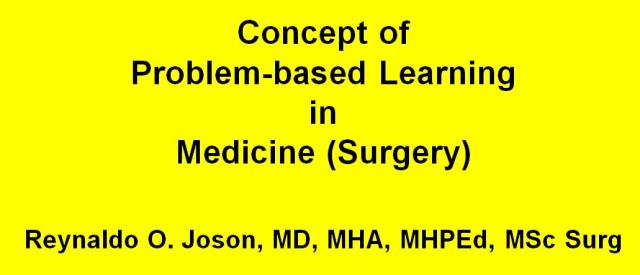Concept of Problem-based Learning in Medicine (in Surgery) – [Re-post #2: May 12, 2012]
This was derived from a module which I wrote in 1997 with the title: Problem-based Learning in Medicine, An Off-campus Study.
I will be using these concepts when I write my blog on “Problem-based Learning in Surgery.” [and when I facilitate the PBL Program for Surgical Residents and Interns in Manila Doctors Hospital, Ospital ng Maynila Medical Center and Philippine General Hospital – May 12, 2012]
ROJoson – May 18, 2011
+++++++++++++++++++++++++++++++++++++++++++
What is Problem-based Learning (PBL) in Medicine (in Surgery)?
PBL is the learning that occurs in the process of solving a problem. Experience has shown that this is mainly how human beings learn to live life and it is undeniably the best way of learning especially in terms of retention and recall of knowledge and skills.
The founders of PBL in medicine recalled their sad experiences with the conventional memory-based medical curriculum – hard to recall facts “learned” in the first 2 years and difficulty in integrating the basic and clinical sciences. They theorized that retention and recall of medical knowledge and skills would be enhanced when learned in a context which closely approximates real life, i.e. clinical problems.
Thus, PBL in medicine has been proposed and it is essentially learning the science and art of medicine in the clinical or functional context.
In the practice of medicine, the following events actually or should take place:
1. A physician meets a patient without prior knowledge of what the patient’s problem is.
2. During the encounter, the physician establishes rapport, diagnoses, treats, and gives advices with the goal of resolution of the health problem of the patient.
3. In the process of understanding and resolving the patient’s problem, the physician invariably encounters some insecurities, questions, and gaps in competencies.
4. The physician fills in the gaps in competencies through various means, such as self-study and learning from other people like consultations, referrals, and enrolling in a formal course.
5. The new competencies acquired are used by the physician on the patient on hand and on future patients.
If PBL in medicine is learning the science and art of medicine in the functional context, then the educational activities should consist of the following:
1. The student is presented with a health problem which can be simulated or actual, without the student having prior study on the problem. This means there is no prior teacher’s lecture nor prior assignment to study on the problem.
2. The student tries to understand and to solve the problem.
3. In the process of trying to understand and to solve the problem, the student will invariably encounter questions, uncertainties, and gaps in competencies, which constitute the so-called “learning issues”.
4. The student then decides how to go about settling the “learning issues”.
5. The student implements his plan of study.
6. The student applies what he learned to the problem on hand as well as to future problems or patients.

